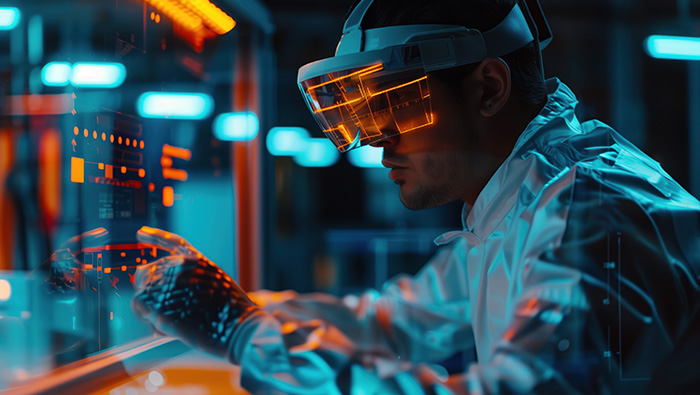You have probably heard your colleagues mention ChatGPT. Every indicator suggests that ChatGPT is a major technological milestone and the beginning of something significant in artificial intelligence. But as a control and automation engineer, you might also wonder whether there are any immediate applications in manufacturing.
ChatGPT stands for ‘Generated Pre-Trained Transformer’. The agent has been trained from a comprehensive web scrape from 2020 to 2021. ChatGPT appears humanlike because it understands plain language requests and provides an authoritative and humanlike response. But there are limitations. For example, the algorithm could be more consistent when presented with an open-ended question or problem requiring significant analysis. The agent also needs to improve when asked about very specialised topics. At the time of writing, there are some serious questions about the agent’s response to ‘trick questions’, and it can even develop an ‘attitude’, perhaps its most humanlike quality!
I expect that there will be many future embarrassing moments for early adopters of ChatGPT.
Gartner has a helpful way of describing the trajectory of emerging technology. The model is named the “hype cycle”. ChatGPT and several similar language processing technologies are at the “peak of inflated expectations”. Next will come the “trough of disillusionment” and a slow, steady climb to the “plateau of productivity”. Only then is the technology considered mature enough to reliably and consistently add business value.
Arthur Clarke described any sufficiently advanced technology as indistinguishable from magic. While ChatGPT is impressive, many more established process automation and control technologies fall in the same category. For years, machine learning has been used in industrial applications to help recognise images, text and speech. But remember, at its core this technology can only provide a statistically probable answer from lots of learned data, and no more than that.
For decades, complex physical systems have been modelled to predict and optimise output based on measured input variables. I remember working on an advanced real-time expert system model for fermentation back in 1995, which, when it worked, also seemed like magic at the time, but it was in no way humanlike, and it had severe limitations.
Machine learning and artificial intelligence are related to each other but different. Machine learning is how mathematical models help a computer ‘learn’ without direct instruction. Artificial intelligence is the capability of a computer system to mimic human cognitive functions. Machine learning is regarded as a subset of AI.
A common technique to predict failure with condition monitoring is an example of using machine learning algorithms built on an underlying reliability model. Other examples include decision support, digital twins, forecasting and modelling; these are generally based on first-principle models and don’t incorporate AI in the strict sense.
AI is machine learning with a lot more. AI mimics human reasoning in ways that a mathematical model cannot. How we interact with AI systems will differ from how we interact with a model. A machine-learned model can be directly embedded in a control system, out of sight and out of mind. An AI system would typically interact with a human user to augment and help with decision making by providing additional context and other important information, usually providing a reasoned and plausible recommendation.
We need to stretch our imagination to predict how AI will affect an industrial operation in the future. Imagine if process operators were guided in their decision making by an experienced AI agent that could help the operator optimise the plant during his shift. Expensive mistakes could be predicted and averted. The AI agent could, in theory, replace the ‘grey-beard’ mentor and offer recommendations based on all learned experience on that plant. We are still some distance from this scenario becoming a reality. Still, it might be helpful at the outset to understand the vision for where this new technology might lead in future and then prepare accordingly.
Emerging AI technologies will require a robust supervisory control platform connected to sensors, process control systems and business applications. The ideal connected platform will allow real-time data ingestion, cleaning and processing of massive data streams for consumption by AI agents. The platform should also be able to give every person an actionable recommendation delivered by real-time messages sent to portable devices and wearables. There have been several recent acquisitions by established process control vendors wanting to acquire new skills and capabilities in these advanced platforms. It is only a matter of time before the leading supervisory control vendors offer some form of AI in their standard control room products.
Because AI interacts with people in a new way, the old human-machine interface may need to be updated, and the people who work with AI systems will need new skills. It will therefore be important to have the right culture within the organisation, open to and willing to leverage advanced technology in the future. The next generation of factory worker is already entering the industry, and soon a ChatGPT-like application will likely be running on computers in the control room − will your operation be ready for this? Do you have processes that support technology innovation in the factory directed at improving business performance? Addressing these challenges will require significant maturity and trust at all levels of the organisation. A culture that accepts innovation, experimentation and learning will likely be able to take faster advantage of emerging AI technologies.
Manufacturing AI will likely find better traction in the ‘smart factory’, especially where there are complex operations with high value throughput − oil refineries, discrete manufacturers like vehicle manufacturing, manufacturers connected to global supply chains, FMCG, etc. The barriers to entry will need to be lowered for smaller companies before they can take full advantage of these technologies in-house, leading to a rapid rise in specialised AI-based products and services offered through the cloud.
Manufacturing AI like ChatGPT will most likely be used to augment and enhance business processes where there is a heightened reliance on external data and context, for example customer service, marketing, contract management, digital commerce and compliance. There will also likely be useful AI applications in human capital management and employee self-service.
Even with the potential positive impact of AI on manufacturing, there are some red flags. Trust will become more critical in future. Connected business systems with AI agents will open a new frontier in data sovereignty, security complexity, and risk. Privacy and social considerations will also become more complicated. Companies that have moved applications to the cloud already have valid concerns about data security. When an AI agent connects to your data, this concern will be amplified by orders of magnitude.
There will, of course, be many failures on the way, and it will be your choice as to how much risk to accept. The stakes are high, and entire industries could be transformed during this unprecedented technological innovation. Visionary and strong technology leadership will be critical to navigating this emerging arena.
This article first appeared in SA Instrumentation and Control, March 2023.


